| Pipevine Swallowtail
Battus philenor
Rare. |
|
| |
|
| Giant Swallowtail
Papilio crespjontes
Rare. This historically southern species has expanded its range
northward, resulting in WPRR records. First recorded August 10, 2014. |
|
|
|
| Eastern Tiger
Swallowtail Papilio glaucus
Common throughout the reservation. Quads D4, D7, F5, F6, G5. May 26 -
September 4. |
|
| |
|
| Spicebush
Swallowtail Papilio troilus
Common throughout the reservation. Quads D4, D7, F5, G5. May 26 - August
13. |
|
|
|
| Black Swallowtail
Papilio polyxenes
Regionally more common on the coastal plain. Uncommon to rare in meadows
at WPRR. Quad D7. May 30 - August 17. |
|
|
|
| Checkered White Pontia
protodice
A rare stray from the south. Quad |
|
|
|
| Cabbage White Pieris
rapae Generally an abundant species, but
only fairly common at WPPR. Quad D4. dates |
|
|
|
| Orange Sulpher Colias
philodice Fairly common in meadows. Quads
D4, D7. ?? to September 24. |
|
|
|
| Clouded Sulphur Colias
eurytheme Uncommon in meadows. Quads D4,
D7. ?? - September 24. |
|
|
|
| Cloudless Sulphur
Phoebis sennae
A rare stray from the south. |
|
|
|
| Little Yellow Eurema
lisa
Rare. Documented in 2004. The host plant is fairly common at WPPR, but this species' normal
range falls short of matching its host range. Quads D7, H5. July -
August. |
|
|
|
| Harvester Feniseca
tarquinius
Current status uncertain. One colony within the reservation and another
just outside were noted between 2005 and 2007. Still likely present, but
not seen annually. Quad D4. August 1 -
August 26. |
|
|
|
| American Copper Lycaena
phlaeas
Common in meadows, especially drier ones. Quad D4, D7, G5, H5. June 26
(likely much earlier) - September 24. |
|
|
|
| Bronze Copper Lycaeana
hyllus Rare. A stray individual was found
in July 1997 and another was documented on June 6, 2021. |
|
|
|
| Coral Hairstreak
Satyrium titus
Formerly fairly common, but searches after 2007 and through 2022
failed to turn up any records. Individuals were found again, beginning
in 2023, along Michigan Road. Quad G5. June
to July. |
|
|
|
| Oak Hairstreak Satyrium
favonius Rare.
Formerly considered a regular inhabitant of the reservation. After
several years with no sightings, a few were found in 2011. This species
was sometimes found in a milkweed patch on Pell Hill that that is now
overgrown. Also possible in the far meadow
at the end of Michigan Road. Quads D7, F5. June 18 - July 11, mainly in
June. |
|
|
|
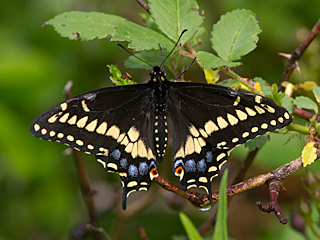 |
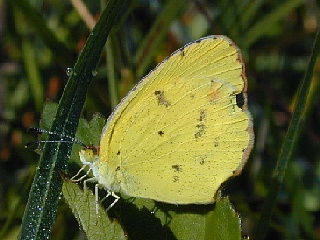 |
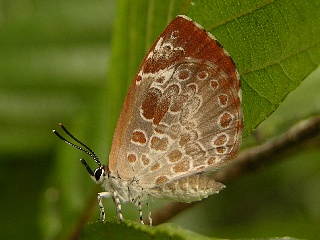 |
| Black Swallowtail, May 30, 2011 |
Little Yellow, July 11, 2004 |
Harvester, August 20, 2005 |
|
|
| |
|
| Acadian Hairstreak
Satyrium acadica Historic. Known
to be present through at least 1996. |
|
|
|
| Edward's Hairstreak
Satyrium edwardsii Probably belongs in
the historic category. A small colony that was long known along
Boutonville Road is now extirpated. Quad H5. June - July . |
|
|
|
| Banded Hairstreak
Satyrium calanus Common. Likely
widespread throughout the reservation but best found by searching the
milkweeds on Pell Hill. Quads D4, G5. June 12 - July 18. |
|
|
|
| Hickory Hairstreak
Satyrium caryaevorum Uncommon. Best
found in the far meadow at the end of Michigan
Road, but in some years may be more difficult to find than in others. Quad D7. June 19 - July
12. |
|
|
|
| Striped Hairstreak
Satyrium liparops Uncommon, but
apparently maintaining a level population at WPRR. Quads D7, F5. June 19
- July 30. |
|
|
|
| Brown Elfin Callophrys
augustinus Common near the top of the
fire tower trail in early spring. Has also been found along Boutonville
Road. Quads G7, H5. April 26 - May 5. |
|
|
|
| Eastern Pine Elfin
Callophrys niphon Rarely seen here.
Associated with large pines and seldom seen at ground level. The most
recent record is from a specimen found May 27, 2019 below pines near the
east end of Boutonville Road. |
|
|
|
| Juniper Hairstreak
Callophrys gryneus Historic. Last
documented record in 1993. Could still be present, as it this species
may not necessarily make itself conspicuous. It should be searched for
in and around the host tree red cedar. Quad D7. May 11 - July 29 in two
broods. |
|
|
|
| White M Hairstreak
Parrhasius m-album Rare. While generally
of southern affinity, this species appears to be locally resident in the
lower Hudson Valley. Quad C6. |
|
|
|
| Gray Hairstreak Strymon
melinus Rare to uncommon. This species
is most commonly encountered on the coastal plain, but does appear
uncommonly inland. Quad F5. Has been found as early as March 17, but
most records in summer and fall. |
|
|
|
| Red-banded Hairstreak
Calycopis cecrops Rare. This is a
generally southern species that is most common regionally on the coastal
plain. A stray individual was present August 25-26, 2007 at flowers
outside the main office, for the first site record. A couple more
individuals were found in 2011. Now appears established as a
resident. Quads C4, F5. June 7 - August 26, in
two broods. |
|
|
|
| Eastern Tailed-Blue
Everes comyntas Common in fields and
meadows throughout the reservation. Quads D4, D7, H5. spring - September
24. |
|
|
|
| Spring (Edward's) Azure Celastrina
ladon Fairly common in early spring
along open woodland trails. Quads G6, G7. March 17 - April 26, mainly in
April. Recent sightings and thinking point to the presence of two
species of spring flying azures here, with Northern Azure Celastrina
lucia included. |
|
Northern Azure Celastrina
lucia Locally common in the reservation
in April.
|
|
| Summer Azure Celastrina
neglecta Fairly common in late spring
and through the summer along open woodland trails and wood edges.
Occasional individuals may also pop out in April. Quads
D4, D7. June 5 - September 4. |
|
|
|
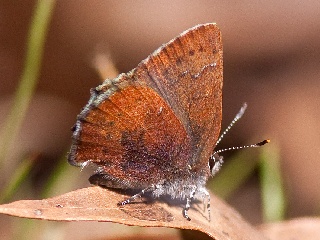 |
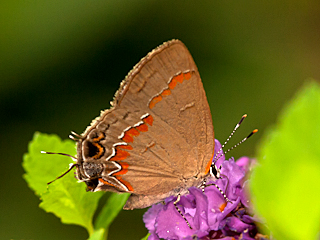 |
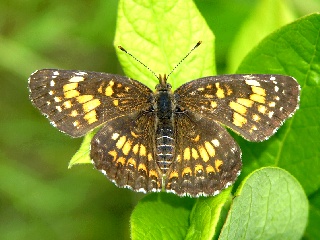 |
| Brown Elfin, April 26, 2009 |
Red-banded Hairstreak, August 26, 2007 |
Harris' Checkerpsot, June 19, 2004 |
|
|
| |
|
| Variegated Fritillary
Euptoieta claudia Rare. This is a
southern species that emigrates into the region to varying degrees from
year to year. Better years have seen some individuals reach WPRR. Quads
D4, D7, I5. May 27 - July 27. |
|
|
|
| Regal Fritillary
Argynnis
Historic. This species has declined tremendously in the Northeast.
Now extremely local. Last known record here in 1966. |
|
|
|
| Great Spangled Fritillary
Argynnis cybele
Although common and conspicuous in the summer months at WPRR, numbers
have declined from a former abundant status. Quads C5, C6, D4, D7. June
6 - September 24. |
|
|
|
| Aphrodite Fritillary
Argynnis aphrodite
Historic. Believed to have been present through at least 1994. July. |
|
|
|
| Meadow Fritillary
Boloria bellona
Historic. Last recorded at WPPR in 20??. Abundant at WPPR and other
locations in northern Westchester as recently as the 1990's, the species
has disappeared. The nearest known stable populations are in Dutchess
County. Quad D4, D7. |
|
|
|
| Pearl Crescent Phyciodes
tharos
Common in open areas throughout the reservation. Quads C5, C6, D4,
D7. May 26 - September 24. |
|
|
|
| Silvery Checkerspot
Chlosyne nycteus
Historic. Last reported in 1996. Quad F5. June. |
|
|
|
| Harris' Checkerspot
Chlosyne harrisii
Fairly common, but numbers are variable from year to year. This is another northern species that has declined
precipitously. It is now apparently gone from Connecticut and New
Jersey. Amazingly, though, the colony at the end of Michigan Road
continues to thrive around its flat top aster host. Quad D7. May 26
- July 2 (May records usually in warm springs only). |
|
|
|
| Baltimore Checkerspot
Euphydryas phaeton
Formerly common in northern Westchester, specializing in turtlehead as a
host plant. A marked decline occurred in the early 2000's, with the
species limited to fewer
locations. It was last documented at WPRR in 2007 and intensive searches in 2010 and
2011 came up empty. However, new populations have begun to appear with a
shift to plantain as the host. A small colony was reestablished in the
Meadow area in 2014, although this appears to have flamed out by the
2020's. Quads D4, D7, I5. June 28 - July 7. |
|
|
|
| Question Mark Polygonia
interrogationis
Fairly common throughout the reservation. Quads D4, D7, G5, H5. May
26 -. |
|
|
|
| Eastern Comma Polygonia
comma
Fairly common throughout the reservation. Quads D4, D7, G5, H5. dates. |
|
|
|
| Compton Tortoiseshell
Nymphalis vau-album
Uncommon but possibly annual. It should be looked for on warm early
spring days when overwintering adults emerge. A recent record near the
museum June 29, 2015. Quads D7, H5. |
|
|
|
| Mourning Cloak Nymphalis
antiopa
Fairly common throughout the reservation. Quads D7. March -
September. |
|
|
|
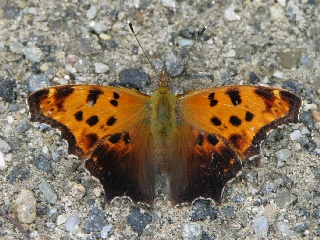 |
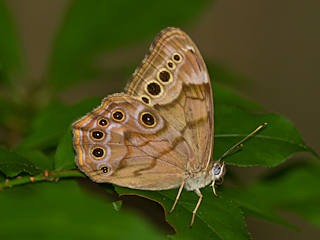 |
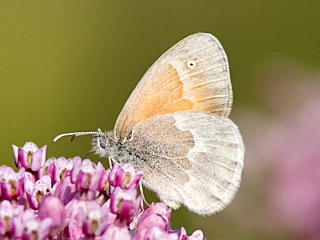 |
| Eastern Comma, June 19, 2004 |
Northern Pearly-eye, July 23, 2011 |
Common Ringlet, August 4, 2007 |
|
|
| |
|
| Red Admiral Vanessa
atalanta
An annual migrant that is variably common at WPRR. Usually seen near
watercourses. Quads D7, G5. May - September. |
|
|
|
| American Lady Vanessa
virginiensis An annual migrant that is
variably common at WPRR. Mostly seen in meadows. Quads D7. 26 May -
September. |
|
|
|
| Painted Lady Vanessa
cardui An irregular migrant that may be
absent some years. |
|
|
|
| Common Buckeye Junonia
coenia An irregular migrant that in most
years is confined to the coastal plain. Generally not expected at WPRR,
but many occurrences possible in good years. Quad D4, D7, F5. June 1 -
September 24. |
|
|
|
| Red-spotted Purple
Limenitis arthemis astyanax Uncommon but
regular at wood edges and often on moist ground. the northerly form
"White Admiral" occurs rarely. Quads D7, G5. May 26 -
?? |
|
|
|
| Viceroy Limenitis
archippus Uncommon but regular in wet
meadows and sometimes on moist ground. Quads D4, D7. May 27 - September
23. |
|
|
|
| Northern Pearly-eye
Enodia anthedon Fairly common along open
woodland trails. Often seen on tree trunks in woodlands. Quads D3, E5,
E6, H5. June 19 - September. |
|
|
|
| Appalachian Brown
Satyrodes appalachia Common in and around
sedge marshes, and along woodland trails in the vicinity of its host
plant tussock sedge. Quads D4, D7, F6, G5. May 30 - September. |
|
|
|
| Little Wood-Satyr
Megisto cymela cymela Common to abundant
in meadows and at wood edges throughout the reservation. Quads D4, D7,
F5, G5, H5. May 26 - July 26. There are two flights which may be
separate species, rather than broods. The earlier flight from late May
into mid June is more abundant. Fresh individuals appear again in late
June, therefore not exhibiting a gap that would be expected of
broods. |
|
|
|
| Common Ringlet
Coenonympha tullia This is a northern
species that expanded its range southward and appears to have reached
the reservation around 1991. Common in meadows, usually wetter ones.
Quads D4, D7. May 22 - September 24 in two broods. |
|
|
|
| Common Wood-Nymph
Cercyonis pegala Common in meadows and at
wood edges throughout the reservation. Quad D4, D7, F5, G5, H5. June 19
- September. |
|
|
|
| Monarch Danaus plexippus
Variably common in open areas throughout the reservation. Nectars at a
wide variety of flowers. Caterpillars may be found by looking on
milkweeds. Quads D4, D7, F5. May 26 - September 24. |
|
|
|
| Silver-spotted Skipper
Epargyreus clarus Fairly common in open
areas throughout the reservation. Quads D4, D7. May 26 - September 24. |
|
|
|
| Hoary Edge Achalarus
lyciades Uncommon but regular. Best found
nectaring at common milkweed on Pell Hill. Quads D4, G5. June 12
- July 2. |
|
|
|
| Southern Cloudywing
Thorybes bathyllus Fairly common in dry
meadows and along open trails. Often found at nectar sources such as
common milkweed. Quads D7, F5, G5, H5. May 31 - July 8. |
|
|
|
| Northern Cloudywing
Thorybes pylades Fairly common in dry
meadows and along open trails. Often found at nectar sources such as
common milkweed. Quads D7, F5, G5, H5. May 26 - June 29. |
|
| |
|
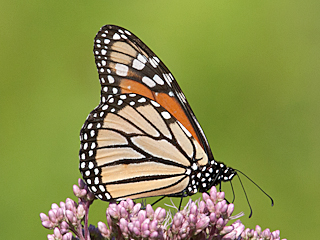 |
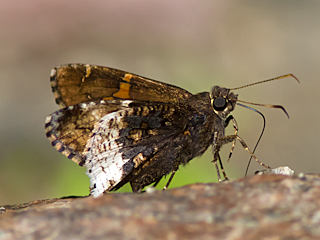 |
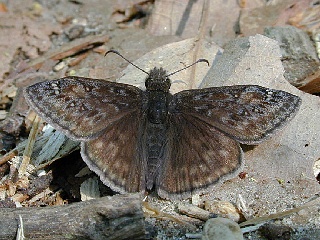 |
| Monarch, July 29, 2006 |
Hoary Edge, June 18, 2011 |
Juvenal's Duskywing, May 5, 2001 |
|
|
Common Sootywing
Pholisora catallus A species usually
inhabiting scrubby or disturded fields, Rare here, but an individual was
seen around 2021 in the vicinity of the Meadow Picnic Area.
|
|
| Dreamy Duskywing Erynnis
icelus Formerly fairly common along
trails and woodland edges, but appears to have declined. Current status
in question. Quads D7, G5, H5. May 21 - June 23. |
|
|
|
| Juvenal's Duskywing
Erynnis juvenalis Common along woodland
trails in spring. Quads F6, H5. April 26 - June 8. |
|
|
|
| Horace's Duskywing
Erynnis horatius Rare. This is a
generally southern species that is most common regionally on the coastal
plain. A stray individual was found August 4, 2007 along Michigan
Road and another August 16, 2015. Quad C6, F5. |
|
|
|
| Wild Indigo Duskywing
Erynnis baptisiae Uncommon but regular.
Best looked for in the vicinity of the host plant used at WPRR, crown
vetch. One location is at the far end of the big lawn at the end of
Michigan Road. Quad D7, F5. July 10 - July 23. |
|
|
|
| Common Checkered-Skipper
Pyrgus communis Rare. An
individual was seen for several days by the shelter at the end of
Michigan Road in early June 2021. |
|
|
|
| Swarthy Skipper Nastra
lherminier Historic. Last
reported in 1989. |
|
|
|
| European Skipper
Thymelicus lineola Formerly abundant in
fields throughout WPRR. This species appears to now occur in scattered
pockets and in smaller numbers, such as the hill alongside the road up
to Pell Hill. Quads D7, E5, F5. May 27 - June 23, but exceptional
before June. |
|
|
|
| Least Skipper
Ancyloxypha numitor Common along grassy
edges of watercourses. Quads D7. May xx - September 23. |
|
|
|
| Cobweb Skipper Hesperia
metea Uncommon, formerly a bit more
common. As of 2024, may be gone. Typically associated with dry meadows and barrens, but may be
found at blue flag iris in wetter meadows. Quads D7, H5. May 14 - June 9. |
|
|
|
| Indian Skipper Hesperia
sassacus Fairly common although some decline
seems to have occurred. Occurs in dry and wet meadows. Best found nectaring
on blue flag iris, but may also wander to lawns with red clover. Quads
D4, D7. May 19 - June 29. |
|
|
|
| Leonard's Skipper
Hesperia leonardus Historic. Last
known record in 1988. Quad D4. |
|
|
|
| Sachem Atalopedes
campestris Rare. Quads D I6. May 30 - June
25. |
|
|
|
| Fiery Skipper Hylephila
phyleus Rare. Quad D7. September 24 |
|
|
|
| Peck's Skipper Polites
peckius Common in wet and dry meadows.
First brood individuals may best be found on lawns, nectaring on red
clover. Second brood individuals include swamp milkweed among their
preferred nectar source. Quad D4, D7. May - September 24 in
two broods, scarce from late June to late July. |
|
|
|
| Long Dash Polites mystic
Common in wet meadows and best found nectaring on blue flag iris. May
also wander to lawns with red clover. Quad D4, D7, E5, F5. May 22 to
June 28, with a rare partial second brood August 20 to September 9. |
|
|
|
| Crossline Skipper
Polites origees Uncommon, but fairly
common in better years. Prefers dry meadows, but may be found at favored
nectar sources throughout the reservation. Quads C4, D4, D7, H5. June 19
to July 31. |
|
|
|
| Tawny-edged Skipper
Polites themistocles Fairly common in
meadows, usually drier ones. Quads C5, D4, D7. May 22 to September, in two
broods. |
|
|
|
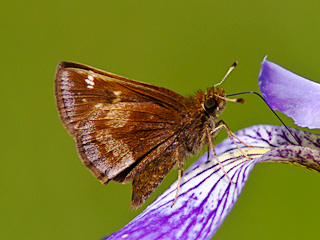 |
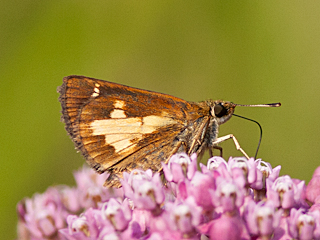 |
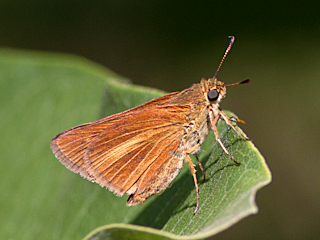 |
| Hobomok Skipper, May 30, 2011. |
Mulberry Wing, July 26, 2008. |
Dion Skipper, June 26, 2010. |
|
|
| |
|
| Little Glassywing
Pompeius verna Abundant in meadows,
particularly wetter ones, throughout the reservation. Abundant at
favored nectar spots, such as the milkweed patch on Pell Hill. Quads C5,
D4, D7, E5, F5, G5, H5. June 12 to July 12. |
|
|
|
| Northern Broken-Dash
Wallengrenia egeremet Fairly common in
meadows, usually drier ones. Quads D4, D7, E5, F5, H5. June 19 to July
10. |
|
|
|
| Delaware Skipper
Anatrytone logan Common in meadows and
favored nectar sites throughout the reservation. Quads C5, D4, D7, E5,
F5, G5, H5. June 19 to July 25. |
|
|
|
| Hobomok Skipper Poanes
hobomok Common in fields and along wood
edges, occasionally in sunlit areas deep within woodlands. Easily seen
at favored nectar source such as blue flag iris and red clover. The
reservation is a good location for finding dark type females, known as
the "Pocahontas" form. Quads D4, D7, G5, H5. May 26 -
July 5. |
|
|
|
| Zabulon Skipper Poanes
zabulon This is a generally southern
species that is common into southern Westchester. Its occurrence at WPRR
appears to be sporadic and more likely with the second brood. Typically
found along wood edges and in woodland clearings. Quad D7. August 13 -
August 26. |
|
|
|
| Broad-winged Skipper
Poanes viator Uncommon. The host plant is
phragmites, which is scarce at WPRR. The species wanders somewhat, and
strays may appear. Best looked for at the button bushes around the small
ponds beyond the main office. Quads C4, D7. July 7 to July 26. |
|
|
|
| Mulberry Wing Poanes
massasoit Common in and around sedge
marshes. Best found at favored nectar spots, such as the swamp milkweeds
at the Michigan Road marsh. Quads D4, D7, E5, G5, H5. July 9 to August
4. |
|
|
|
| Black Dash Euphyes
conspicua Common in and around sedge
marshes. Best found at favored nectar spots, such as the swamp milkweeds
at the Michigan Road marsh. Quads D4, D7, E5, G5, H5. June 26 to July
26. |
|
|
|
| Dion Skipper Euphyes
dion Uncommon. This has generally been
considered a rare species in Westchester, but there appears to be an
indication of a recent increase. Best looked for at the milkweed patch
in the sand pit near the end of Boutonville Road. Quads D7, H5. June 23
- July 7. |
|
|
|
| Dun Skipper Euphyes
vestris Abundant in meadows, particularly
wetter ones, throughout the reservation. Abundant at favored nectar
spots, such as the milkweed patch on Pell Hill. Quads C5, D4, D7, E5,
F5, G5, H5. June 19 to July. |
|
|
|
| Dusted Skipper
Atrytonopsis hianna Uncommon but a
little effort can usually lead to finding a few at the peak of its
flight. Best looked for in the sand pit near the end of Boutonville Road
and in the fields at the end of Michigan Road. Quads D4, D7, H5. May 15
to June 14. |
|
|
|
| Pepper And Salt Skipper
Amblyscirtes hegon Historic, but still
possible. This is a northern species, usually found in higher elevations
in its closest occurrences near Westchester. A number of records were
obtained in the first half of the 1990's, mostly at red clovers at the
end of Michigan Road. The most recent record came June 16, 2001 in the
Boutonville Road parking lot. Quads D7, G5. June 12 to June 18. |
|
|
|
| Ocola Skipper Panoquina
ocola Rare. Quad D7. |
|














